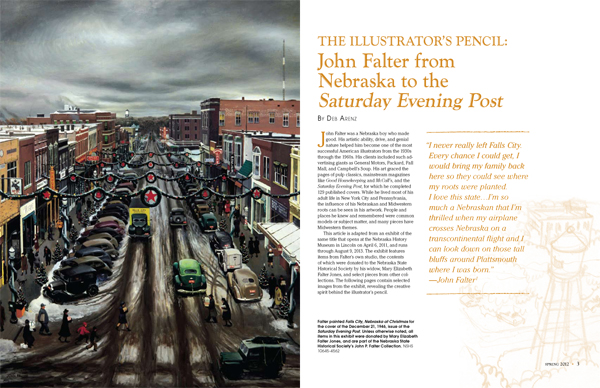
John Falter was a Nebraska boy who made good. His artistic ability, drive, and genial nature helped him become one of the most successful American illustrators from the 1930s through the 1960s. His clients included such advertising giants as General Motors, Packard, Pall Mall, and Campbell’s Soup. His art graced the pages of pulp classics, mainstream magazines like Good Housekeeping and McCall’s, and the Saturday Evening Post, for which he completed 129 published covers. While he lived most of his adult life in New York City and Pennsylvania, the influence of his Nebraskan and Midwestern roots can be seen in his artwork. People and places he knew and remembered were common models or subject matter, and many pieces have Midwestern themes.
This article is adapted from an exhibit of the same title that opens at the Nebraska History Museum in Lincoln on April 6, 2011, and runs through August 9, 2013. The exhibit features items from Falter’s own studio, the contents of which were donated to the Nebraska State Historical Society by his widow, Mary Elizabeth Falter Jones, and select pieces from other collections. The following pages contain selected images from the exhibit, revealing the creative spirit behind the illustrator’s pencil. Falls City to Kansas City John Philip Falter was born in Plattsmouth, Nebraska, in 1910 to a close-knit, artistic family. In 1916 parents George and Margaret moved John and his younger sister Suzanne to Falls City, where his father opened Falter’s Clothing Store. Falter’s family recognized and encouraged his artistic talent early on. During World War I, his grandmother sold stamps for the war effort by offering people who bought them Falter’s drawing of the Kaiser riding a motorcycle.
At seven, Falter was enrolled in an art class taught by noted regional painter Alice Cleaver. He disliked the discipline of the class and soon was forging Cleaver’s signature onto his own drawings so he could skip class without his mother knowing. As a teenager Falter was interested in cartoons, movies, and jazz. His passion for jazz was lifelong–he became an accomplished self-taught musician–and surfaced occasionally as a theme in his paintings. As a young artist he was influenced by many of the popular cartoonists of the day: John Held, Jr., James Montgomery Flagg, Russell Patterson, Dorman Smith, and J. M. “Ding” Darling. Falter’s father took him to visit Darling, a syndicated cartoonist with the Des Moines Register, to investigate a career in cartooning after John graduated from high school in 1928. In later years Falter recalled: “Ding took one look at what I had done and said, ‘This boy should be an illustrator not a cartoonist, because he doesn’t caricature his work enough. He draws too well.'” At Darling’s suggestion, John enrolled in the Kansas City Art Institute (KCAI). His family followed him and eventually relocated in Atchison, Kansas. At KCAI Falter studied under illustrator Monte Crews and learned the two fundamentals of illustration: depicting dramatic moments from text and conveying the meaning instantly to the viewer. Crews discouraged the use of photographs in setting the stage for a painting, thinking the resulting work would lack motion and life. He instead taught his students to use live models and props. Falter later said: “Monte led me into Howard Pyle, N. C. Wyeth, all the great illustrators. He gave me a sense of what could be done with illustration and I got really interested.” The entire essay written by Deb Arenz appears in the Spring 2012 issue




